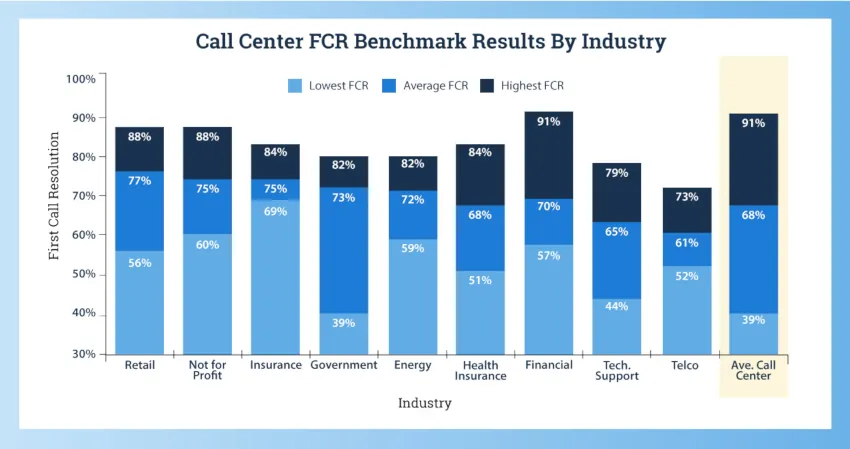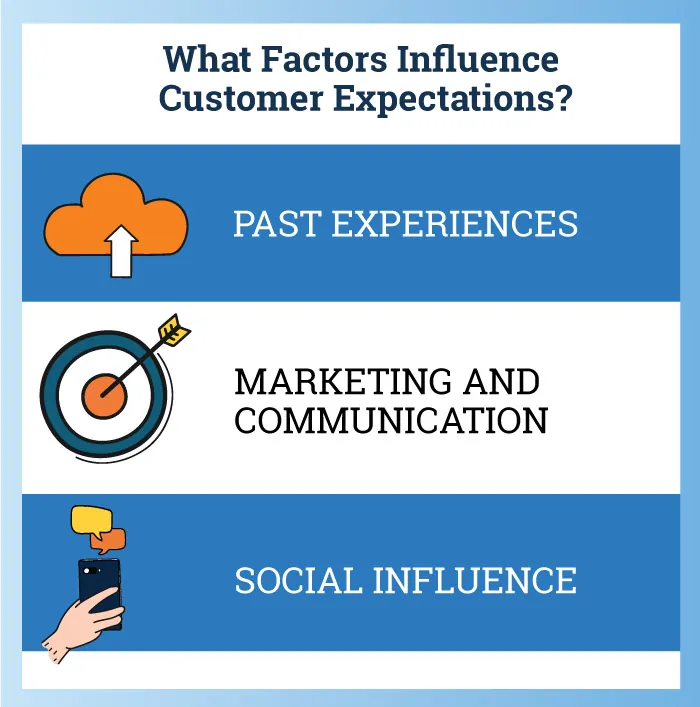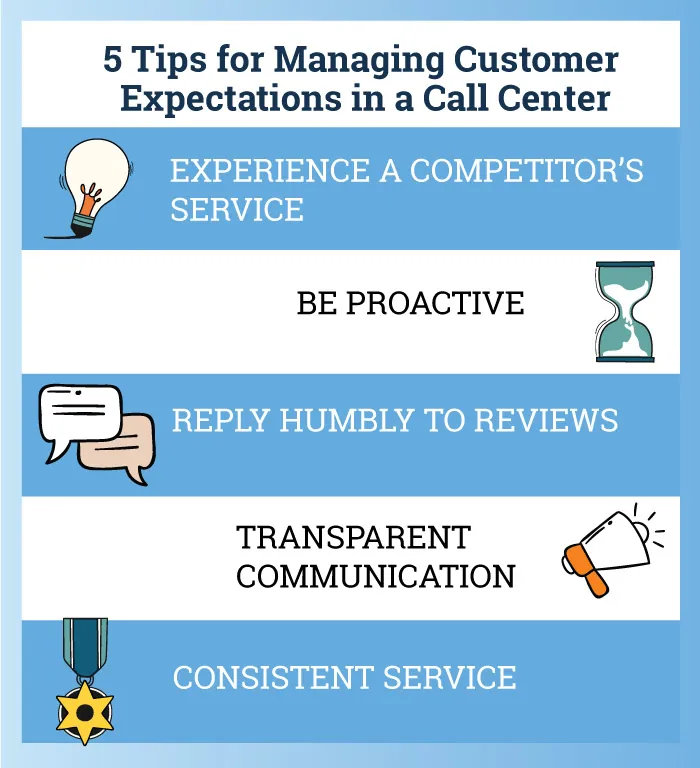SQM research shows that 88% of people have stopped doing business with a company due to poor call center customer service. That statistic alone should motivate you to ensure that your call center is meeting or exceeding customer expectations.
Prevent your customers from leaving and doing business with your competitors by learning to manage customer expectations in your call center and maintaining high customer satisfaction (Csat). This blog will give you tips on how to be proactive by ensuring your customers are consistently satisfied.
Today's connected customers expect to resolve their inquiries on the first contact regardless of what contact channel they choose to use. This is based on SQM's research of benchmarking over 500 leading North American contact centers and conducting 7.5 million surveys. In fact, SQM research shows that 93% of customers using the call center channel and 72% of customers using the website channel expect to resolve their inquiry or problem on the first contact.
What Are Customer Expectations?
Customer expectations refer to the set of anticipations, wants, and standards that consumers hold regarding the products, services, and experiences they receive from a particular company. These expectations are formed based on a combination of past experiences, marketing messages, word-of-mouth, and the perceived reputation of the business.
Customer expectations can include the quality of the product, service efficiency, pricing, agent interactions, and overall satisfaction. Meeting or exceeding customer expectations is crucial for building strong relationships and ensuring repeat business. Failing to meet these expectations can lead to disappointment, customer churn, negative reviews, and, ultimately, a decrease in customer retention.
For example, a customer purchases a new smartphone and notices a slight defect in the camera lens. They call the phone manufacturer's customer support to inquire about a replacement. The customer expects the call center agent to provide information about the return process, including how they will receive a replacement device and the estimated time frame for the exchange.
SQM Group's research shows that the number one thing customers expect from call centers is fast resolution for resolving their inquiries or problems. However, customer expectations fluctuate by industry. For example, customers might have lower hopes for first-call resolution (FCR) if they are calling the Technology Support industry compared to a company in the Financial industry.

Contact Us for a Benchmark Demo
A senior SQM consultant will share an example of the benchmark report, which includes methodology, your performance for KPIs and metrics, benchmark comparison, and targeted opportunities for improvement. In addition, you will have the opportunity to get a free trial with mySQM™ Customer Service QA Software using your own data.
What Factors Influence Customer Expectations?
Below are the three main factors that influence customer expectations:

-
Past Experiences: Customers' previous interactions with a brand or product heavily shape their expectations. Positive experiences lead to higher expectations, while negative experiences can lead to lower or cautious expectations. Consistency in delivering quality experiences builds trust and influences what customers anticipate.
A customer has previously interacted with a certain company's call center to resolve an issue with their internet service. The representative was courteous, knowledgeable, and swiftly resolved the problem. Based on this positive experience, the customer now expects similar efficiency and professionalism when they contact any call center for assistance. Their past experience has set a benchmark for the kind of service they anticipate.
-
Marketing and Communication: Brand messaging, advertising, and communication significantly impact customer expectations. How a company portrays its products, services, and values can create certain perceptions that customers expect to be fulfilled. Overpromising in marketing can lead to unrealistic expectations, while transparent and accurate communication helps set more accurate ones.
A company launches a marketing campaign highlighting its new premium support package, promising 24/7 access to highly trained representatives for instant issue resolution. Through the campaign, customers are led to expect a higher level of support compared to standard offerings. Consequently, when they contact the call center and experience anything less than the premium service advertised, their expectations might not align with the reality of their interaction.
-
Social Influence: Recommendations from friends, family, online reviews, and social media play a significant role in shaping customer expectations. Positive reviews and testimonials can raise expectations, while negative feedback can lower them. People tend to rely on others' experiences to guide what they expect from a brand or product.
A customer sees multiple positive reviews on social media praising a particular call center for its quick response times and knowledgeable agents. These reviews create a social influence, shaping the customer's expectations before they even reach out for assistance. As a result, they expect prompt and effective support similar to what others have shared in their reviews.
How Can You Manage Customer Expectations?
Managing customer expectations involves several strategies aimed at aligning what customers anticipate with what your business can deliver. Clear and transparent communication is key – accurately depict your product or service in marketing materials and interactions. Set realistic promises to avoid over-promising.
Delivering consistent experiences allows your customers to know what to expect each time they do service with you. By effectively managing consumer expectations, you can enhance customer satisfaction, reduce misunderstandings, and foster long-term relationships.
5 Tips for Managing Customer Expectations In a Call Center


1. Experience a Competitor's Service: A good way to understand customer expectations is to experience your direct competitor's service and compare it with your company's service. Customers expect their experience to be similar or exceed that of your competitor's.
If your business' customer experience does not compare or exceed your competitor's, you will likely lose customers to them as they will be considered the superior option. Therefore, take note of where your competitors surpass you and make sure you are actively working on addressing and improving those areas.
For example, if you are working for an internet service provider company, you might want to try out the competitor's service so that you can experience for yourself what perks or benefits they offer that your company does not. It also allows you to see a different way of doing things that might work better for your company in the long run.
A great way to see how your call center compares to others is to do SQM’s Benchmark Study. SQM benchmarks your call centers’ customer service delivery against the performance of over 500 leading North American call centers. SQM uses a standardized approach for measuring First Call Resolution with all FCR benchmarking participants.

2. Be Proactive: Keep customers informed about any potential delays, changes, or updates that might affect their experience. Proactively reach out to customers if there are known issues or if a service disruption is expected. This prevents surprises and shows that your company values transparency.
If you know that your call center is short-staffed, for example, let your customers know that wait times might be a bit higher than normal so that they can consider the option of calling back another day when there are more agents available. This would help prevent customers from growing impatient and getting frustrated.

3. Reply Humbly to Reviews: 93% of consumers say that reviews are a big influence on whether they will purchase a new product. And, yes, bad reviews are not ideal and can often damage your company's reputation; however, the way that your company responds to those bad reviews can make a world of difference.
When a customer leaves a negative review, it is crucial to put down your defenses and respond in a humble and open-minded way. This shows your potential consumers that you care about your customers and that you are open to receiving feedback and improving.
For example, if a customer leaves a bad review complaining about rude customer service, a good response would be: "We are so sorry that you had a bad experience. We will investigate this further and put the necessary measures in place to ensure that this doesn't happen again."

4. Transparent Communication: Ensure that your call center agents communicate clearly and transparently with customers. Provide accurate and detailed information about products, services, pricing, and any potential limitations. Avoid making promises that cannot be kept, and set realistic expectations from the start..
It's also important to set realistic timeframes. When addressing customer inquiries or resolving issues, provide realistic timeframes for resolution. If a callback, solution, or follow-up is needed, communicate the expected timeline. Meeting or exceeding these timelines helps build trust and prevents customer frustration.

5. Consistent Service: Strive for consistency in service quality and information across all interactions and channels. Whether customers contact your call center via phone, email, chat, or social media, the information and assistance provided should be uniform. This ensures a cohesive customer experience and avoids confusion.
The more consistent the service, the stronger the trust in the brand. If a consumer always gets good service when they call a company, they will associate that company with excellent customer service. This drastically increases the chances of that customer recommending the company to their peers.
What Are the Top 5 Types of Customer Expectations?
1. Explicit Expectations
These are directly communicated and clearly stated expectations that customers have about a product, service, or interaction. They can be based on marketing materials, product descriptions, and explicit promises made by the company.
For example, a customer contacts a call center to inquire about a product's warranty coverage. They explicitly expect the agent to provide clear details about the warranty period, terms, and conditions, as this information was stated in the product manual.
2. Implicit Expectations
Implicit expectations are unspoken assumptions that customers hold based on their prior experiences, industry norms, and their understanding of how things "should" work. They're often deeply ingrained and can significantly impact customer satisfaction.
An example would be a customer calls a call center to report a technical issue with their software. They implicitly expect the agent to have a deep understanding of the product and its features, assuming that technical support personnel possess expertise in troubleshooting various software problems.
3. Interpersonal Expectations
These relate to the way customers expect to be treated by company representatives and staff. This includes expectations for courteousness, empathy, professionalism, and the overall quality of interactions.
For example, a customer who has experienced multiple billing errors calls the call center to resolve the issue. They expect the agent to not only rectify the billing problem but also display empathy and understanding towards their frustration.
4. Digital Expectations
In the digital age, customers have expectations related to online experiences. This includes the functionality and user-friendliness of websites, ease of navigation, responsiveness of online support, and the overall digital presence of the brand.
This type of expectation could be demonstrated when a customer initiates a live chat on the company's website to inquire about product specifications. They expect a quick and efficient response, as digital interactions have conditioned them to anticipate rapid assistance through online channels.
5. Dynamic Performance Expectations
These expectations pertain to how customers anticipate a product or service to perform in various scenarios or under different conditions. Customers might expect a certain level of performance, reliability, or adaptability based on their usage needs.
For example, a customer contacts the call center to troubleshoot an issue with their internet service. They expect the call center agent to guide them through a step-by-step resolution process, ensuring that the service remains stable even during peak usage times.
